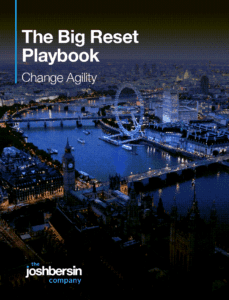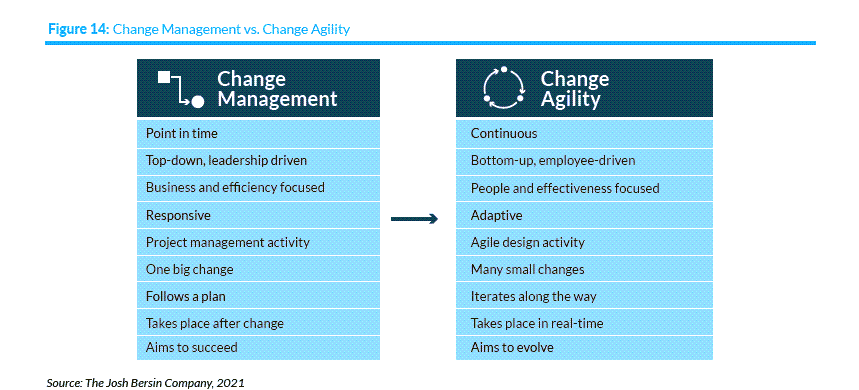What The Pandemic Taught Us About Change
Despite all its downsides, this pandemic has been somewhat miraculous for business. We can work productively from home, we can buy food and entertainment from our phones, nearly everything can be delivered quickly, and our consumer experiences are safe, fast, and digital.
In fact, just about every company, every product, and every service has been transformed. And it all happened in two years. How have companies been able to create such rapid and massive change?
Well we’ve been studying this in detail, and it’s time for a new set of rules. And this week we’ve published it: we call it The Change Agility Playbook: Ten Lessons in Change Agility.
 As Kathi Enderes points out in her LinkedIn article, this work is a result of two years of study. We surveyed, interviewed, and had discussions with more than 1,400 companies. We conducted hundreds of hours of group meetings through our Big Reset groups, and we listened to what was working. And the big message is clear.
As Kathi Enderes points out in her LinkedIn article, this work is a result of two years of study. We surveyed, interviewed, and had discussions with more than 1,400 companies. We conducted hundreds of hours of group meetings through our Big Reset groups, and we listened to what was working. And the big message is clear.
Change Agility has nothing to do with “change management.” It is a new roadmap for culture, management, learning, and rewards that I believe has become a manifesto for growth in the future.
As I discuss in this week’s podcast, your ability to change is one of the most fundamental strengths you have. Business, by definition, is all about adaptation. Yes, you may be making a ton of money in your current business today. But I can guarantee that some technology shift, competitive move, or customer change will interrupt it. So building a company that is “architected for change” is critical.
Ford Motor has gone from fuel-powered to electric-centric in only a few years. Lego has created a new era of play and grown at unprecedented rates. Astra Zeneca, Sanofi, Bayer, and Moderna have hired and expanded their science by orders of magnitude. McDonald’s can now hire and change wages in minutes, without the need for recruiters. And Mercy Bonsecours, Kaiser Permanente, and Provident health have transformed how they deliver healthcare.
None of this is over: each of these companies have set in place a new agenda with lots of work yet to do. And the tight labor market and hot economy is making it more urgent. But facing both the pandemic and competitive pressure from digital-first startups and incumbents, these and other companies have learned what “being agile” really means.
The big message in the playbook is something important I want you to know. Change Agility is not “Change Management.” In fact, the enormous and profitable practice of “change management” itself has to change.
Change Agility is not just about training and communications. It’s about human-centered leadership, building a strong culture of purpose, taking care of your people, and creating a design discipline of “micro-nudges” and stories that bring people to the new world.
 |
I encourage you to join us in this journey, read through this research, and talk about it with your team. Just last week I talked with two of the fastest-growing companies in the world (a pharma and a digital consulting firm) and they both told me the same thing. We’re exploding with growth, but we need a new manifesto to make this sustainable and enduring.
That’s what “Change Agility” is all about. This is a new management discipline for all of us, and it will help us with our teams, our organizations, and our lives.
Additional Resources
The Ten Lessons Of Change Agility
The Healthy Organization: A New Approach to Employee Wellbeing, Resilience, and Growth


